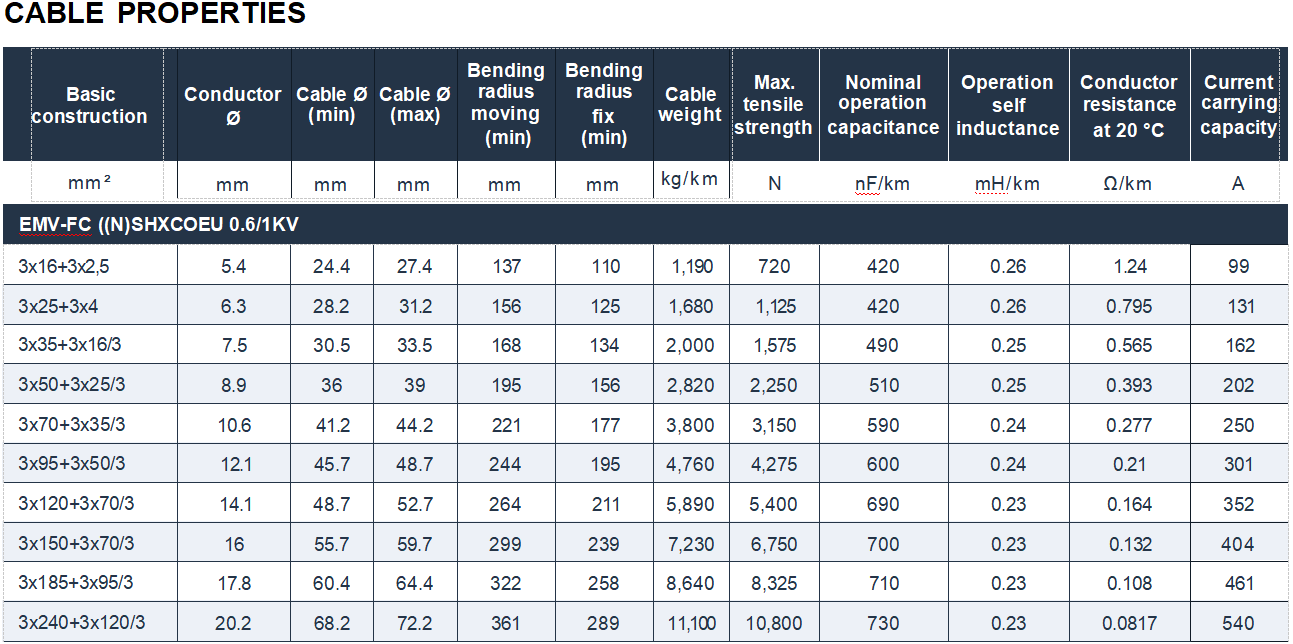📞+86 153 7530 2641 📧 hongjing.Wang@feichuncables.com

High-Performance EMV-FC (N)SHXCOEU 0.6/1 KV Motor Power Supply Cable for Mining & Construction – Variable Frequency Drive Applications (Heavy-Duty, Flexible, Fixed Installation)
Discover the EMV-FC (N)SHXCOEU 0.6/1 KV motor power supply cable designed for variable frequency drive and frequency converter systems in mining and construction. This heavy-duty, flexible cable offers fixed installation and continuous movement reliability for cable booms, material handling equipment, and VFD-controlled drives. It is perfect for harsh environments requiring abrasion resistance and mechanical
hongjing.Wang@Feichun
10/13/202515 min read


Introduction to EMV-FC (N)SHXCOEU 0.6/1 KV Cable
The EMV-FC (N)SHXCOEU 0.6/1 KV represents a sophisticated engineering solution specifically developed for powering variable frequency drive (VFD) and frequency converter-controlled motors in the most demanding industrial environments. This motor power supply cable combines advanced materials technology with robust construction principles to deliver reliable electrical power transmission in mining operations, construction sites, and material handling applications where conventional cables would fail prematurely.
In modern mining and construction operations, the transition towards electrified, data-driven equipment fleets has created unprecedented demands on electrical infrastructure. As operations increasingly rely on VFD technology to optimise energy efficiency and equipment performance, the supporting cable systems must accommodate not only standard power transmission requirements but also the unique electrical characteristics generated by frequency conversion equipment. The EMV-FC (N)SHXCOEU cable addresses these challenges through specialised design features that mitigate electromagnetic interference whilst maintaining mechanical integrity under severe operational stresses.
This cable model serves dual purposes in industrial installations: it functions equally well in fixed installation scenarios where permanent cable routes are established, and in flexible operation contexts where continuous movement occurs, such as cable boom systems connecting mobile machinery or vertical connections between upper and lower cars in material handling equipment. This versatility makes the EMV-FC (N)SHXCOEU an essential component in comprehensive electrification strategies for operations seeking to consolidate their cable inventory whilst maintaining operational reliability.
Key Features and Specifications
Voltage Rating and Electrical Performance
The EMV-FC (N)SHXCOEU cable operates at a rated voltage of 0.6/1 kV (U₀/U), with a maximum rated voltage (Um) of 1.2 kV, making it suitable for low voltage distribution systems commonly employed in mining and construction environments. The cable also accommodates alternative voltage configurations of 640/1140V, providing flexibility for operations using different electrical standards. With a peak voltage tolerance of 2400V and a test voltage specification of 5 kV, the cable demonstrates substantial electrical insulation margins that protect against voltage transients and electrical stress conditions typical in VFD applications.
The electromagnetic compatibility (EMC) features integrated into the cable design represent critical performance characteristics for variable frequency drive applications. The specialised screening construction effectively contains the high-frequency harmonic content generated by frequency converters, preventing electromagnetic interference from affecting adjacent control systems, instrumentation circuits, or communication networks. This EMC compatibility ensures reliable operation in complex electrical environments where multiple systems operate in close proximity.
Construction and Material Composition
The conductor assembly utilises finely stranded tinned copper conforming to Class 5 flexibility standards, providing the mechanical pliability required for installation in confined spaces and operation under dynamic flexing conditions. Tinning the copper strands enhances corrosion resistance in humid environments and improves electrical connectivity at termination points. Available cross-sectional areas range from 16 mm² to 240 mm², allowing specification engineers to select appropriate conductor sizes based on load requirements and voltage drop calculations.
Core insulation employs EPR (Ethylene Propylene Rubber) with a specialised compound designation, delivering superior electrical insulation properties across the operational temperature range. EPR insulation provides excellent dielectric strength whilst maintaining flexibility at low temperatures, a crucial characteristic for equipment operating in underground mining environments or exposed surface locations. The three main power conductors incorporate split earth conductors positioned in the interstices between phase conductors, optimising the cable's circular geometry and providing dedicated protective earth paths with low impedance characteristics.
The screening system comprises tinned copper braiding applied over the core assembly, creating a comprehensive electromagnetic shield that intercepts radiated electromagnetic interference whilst providing a low-resistance path for induced currents. This screening configuration proves particularly effective in VFD applications where the switching frequencies of power electronics generate substantial electromagnetic field components. The inner sheath, constructed from waterproof EPR compound, provides additional mechanical protection for the screened core assembly whilst creating a moisture barrier that prevents water ingress even under continuous submersion conditions.
The outer sheath utilises chlorinated polyethylene (CM/CPE) formulated for exceptional resistance to abrasion, chemicals, oils, and ultraviolet radiation. This sheath material maintains its protective properties across the specified temperature range and resists degradation from exposure to mineral oils, diesel fuel, hydraulic fluids, dilute acids, and alkaline solutions commonly encountered in mining and construction environments. The flame-retardant formulation complies with EN/IEC 60332-1-2 standards, ensuring controlled fire propagation characteristics essential for underground installation approval.
Mechanical Robustness Parameters
The cable construction achieves a permanent tensile strength rating of 15 N/mm², calculated based on conductor cross-sectional area, providing substantial resistance to installation pulling forces and operational tension loads. This tensile capacity accommodates the mechanical stresses imposed during cable installation through ductwork, vertical shaft installations, and drag chain systems without compromising conductor integrity or insulation performance.
Bending radius specifications differentiate between fixed installation applications, where the minimum radius equals 4 times the cable outside diameter, and flexible operation scenarios requiring a minimum radius of 5 times the cable diameter. These specifications prevent excessive mechanical stress on conductor strands and insulation systems that would lead to premature failure. For cable sizes ranging from 24.4 mm to 72.2 mm outside diameter, the corresponding minimum bending radii ensure compatibility with standard cable management hardware whilst protecting the cable's structural integrity.
The maximum operating temperature reaches 90°C for continuous duty, with short-circuit temperature limits of 250°C, providing thermal margins appropriate for VFD applications where harmonic currents may generate additional conductor heating beyond fundamental frequency losses. The cable functions reliably across ambient temperature ranges from -40°C to +80°C in fixed installations and -25°C to +60°C in flexible applications, accommodating the temperature extremes encountered in both underground mining environments and exposed surface installations.


Applications in Variable Frequency Drive (VFD) and Frequency Converter Systems
Motor Power Supply for VFD-Controlled Drives
Variable frequency drive technology has revolutionised motor control in mining and construction applications by enabling precise speed regulation, soft starting capabilities, and regenerative braking functions that improve operational efficiency and reduce mechanical stress on driven equipment. However, the electrical characteristics of VFD output circuits differ substantially from conventional fixed-frequency power supplies, creating unique challenges for cable systems.
VFD output waveforms contain significant harmonic content due to the pulse-width modulation (PWM) switching techniques employed by power electronics. These harmonics generate higher frequency currents that increase cable heating through skin effect and proximity effect phenomena. The EMV-FC (N)SHXCOEU cable accommodates these thermal challenges through appropriate derating factors applied during cable sizing calculations, ensuring conductor temperatures remain within acceptable limits even under worst-case harmonic loading conditions.
The rapid voltage transitions characteristic of PWM switching create substantial electromagnetic field components that can induce interference currents in adjacent circuits. The integrated screening system in the EMV-FC (N)SHXCOEU cable contains these electromagnetic fields, preventing interference with programmable logic controllers, instrumentation systems, communication networks, and other sensitive electronic equipment operating in proximity to the motor power supply circuits. This screening effectiveness proves particularly critical in modern mining operations where autonomous equipment relies on continuous communication systems for coordinated operation.
Use Cases in Mining Sites and Construction Environments
Underground mining operations present among the most challenging environments for electrical cable systems. The combination of mechanical abuse from rock fall and equipment contact, exposure to ground water and chemical contaminants, temperature variations, and the requirement for fail-safe operation creates a demanding operational context. The EMV-FC (N)SHXCOEU cable addresses these challenges through its comprehensive protection systems and robust construction.
In underground coal mining applications, the cable supplies power to continuous miners, longwall shearers, shuttle cars, and conveyor drive systems equipped with VFD controls. The frequency converter technology enables precise cutting speed adjustment for continuous miners, optimising productivity whilst managing cutter motor temperature. For longwall operations, VFD-controlled armoured face conveyors and beam stage loaders benefit from the soft-starting capabilities that reduce mechanical shock on drive components whilst the screening effectiveness prevents interference with longwall automation control systems.
Hard rock mining operations utilise the cable for powering VFD-controlled ventilation fans, dewatering pumps, crushers, and materials handling equipment. Large submersible dewatering pumps operating at depths exceeding 500 metres benefit from the cable's waterproof construction, which maintains insulation integrity under continuous submersion in mine water potentially containing dissolved minerals and suspended solids. The cable's rating for permanent use in waste water up to 40°C at maximum depths of 500 metres specifically addresses these applications.
Construction sites employ the cable for powering mobile cranes, concrete pumps, batch plants, and materials hoists equipped with frequency converter drives. The cable's resistance to construction site contaminants including cement slurry, form-release agents, and diesel fuel prevents premature degradation. The flexibility characteristics facilitate installation in temporary cable management systems whilst the mechanical strength withstands the impacts and abrasion typical of active construction environments.
Tunnelling operations for infrastructure projects represent another critical application domain. Tunnel boring machines (TBMs), roadheaders, and jumbo drills increasingly incorporate VFD technology for optimising cutting tool speed and thrust force. The EMV-FC (N)SHXCOEU cable provides reliable power transmission in the confined, humid, and mechanically aggressive environment characteristic of tunnel development operations. The flame-retardant properties prove essential for meeting the stringent fire safety requirements applicable to underground transportation infrastructure projects.
Fixed Installation Versus Flexible Operation Applications
Fixed installation applications involve cable routes where mechanical movement does not occur during normal operation, though the cable must accommodate thermal expansion, contraction, and occasional repositioning. In these contexts, the cable might supply power from a distribution panel to a stationary VFD cabinet, which then powers a variable-speed motor controlling a fixed conveyor system, crusher, or processing plant equipment. The installation follows established cable tray routes, conduit systems, or underground duct banks with appropriate support spacing and mechanical protection.
Cable boom applications represent a demanding flexible operation scenario where continuous movement occurs throughout the operational cycle. Mobile equipment such as bulk material stackers, reclaimers, and ship loaders incorporate cable boom systems that maintain power supply connections whilst the equipment traverses along rails or rotates through substantial arcs. The EMV-FC (N)SHXCOEU cable's construction accommodates the continuous flexing cycles imposed by these applications without developing conductor fatigue or insulation cracks that would lead to premature failure.
The connection between upper and lower cars in material handling equipment creates another flexible operation scenario. Cranes, hoists, and elevating work platforms require reliable power transmission through cables that flex repeatedly as the equipment operates. The split earth conductor design in the EMV-FC (N)SHXCOEU cable maintains low earth impedance throughout the flexing cycles, ensuring effective ground fault protection remains available even as the cable bends. The waterproof construction protects against moisture ingress in outdoor installations exposed to precipitation and humidity.
Festoon systems used in underground mining and material handling operations suspend cables from trolleys that travel along I-beam tracks, maintaining power connections to mobile equipment whilst preventing cable damage from dragging on the floor. The EMV-FC (N)SHXCOEU cable's flexibility and abrasion resistance make it suitable for festoon applications, though the specific bending radius requirements must be accommodated in the festoon hardware design to prevent excessive mechanical stress.


Benefits for Heavy Mechanical Stress Environments
Resistance to Abrasion, Impact, and Bending Fatigue
The chlorinated polyethylene outer sheath demonstrates exceptional abrasion resistance, measured through standardised testing protocols that quantify material loss under defined mechanical stress conditions. This property proves critical in applications where cables contact moving equipment, drag across rough surfaces, or experience impact from falling materials. Mining operations particularly benefit from this characteristic, as cables frequently route through areas where rock fragments, tools, and equipment create continuous abrasion hazards.
Impact resistance prevents catastrophic cable failure when heavy objects strike the cable during installation or operation. The layered construction, with the resilient EPR inner sheath absorbing impact energy before it reaches the conductor assembly, provides substantial mechanical protection. Field experience in underground mining demonstrates that properly specified cables withstand rock falls and equipment contact that would sever cables with inferior mechanical properties.
Bending fatigue resistance determines cable service life in applications involving repetitive flexing. The finely stranded conductor construction distributes mechanical stress across numerous individual strands, preventing the stress concentration that would occur in rigid conductor designs. Each flexing cycle imposes microscopic plastic deformation on individual conductor strands, but the fine stranding pattern ensures that thousands of flexing cycles occur before accumulated fatigue leads to conductor breakage. The EPR insulation system likewise accommodates repeated bending without developing cracks that would compromise insulation integrity.
Extended Service Life Under Continuous Movement
The economic benefits of extended cable service life prove substantial in mining and construction operations where cable replacement requires equipment shutdown, creates safety hazards for maintenance personnel, and consumes valuable operational time. The EMV-FC (N)SHXCOEU cable's design specifically addresses the failure mechanisms that limit service life in demanding applications.
Conductor fatigue represents the primary failure mechanism in flexible cable applications. The Class 5 stranding pattern, combined with appropriate conductor sizing that prevents excessive current density, ensures that thermal cycling and mechanical flexing cycles accumulate slowly toward the fatigue failure threshold. Operations report service life exceeding ten years in continuous-duty festoon applications, compared to three to five years for cables not specifically designed for flexible operation.
Insulation degradation from combined electrical, thermal, and mechanical stress eventually limits cable service life even when conductor integrity remains acceptable. The EPR insulation system resists thermal ageing more effectively than PVC alternatives, maintaining dielectric strength and mechanical properties throughout extended service periods. The moisture barrier properties of the inner sheath prevent water treeing and electrochemical degradation that would prematurely compromise insulation performance in humid environments.
Sheath damage from mechanical abuse creates water ingress paths that accelerate degradation of underlying cable layers. The chlorinated polyethylene formulation demonstrates superior cut-through resistance and tear propagation properties compared to standard rubber compounds, providing lasting mechanical protection even in the most aggressive operational environments. This durability translates directly to reduced maintenance costs and improved operational reliability.
Reduced Downtime and Maintenance Costs
Unplanned equipment downtime represents one of the highest costs in mining and construction operations, with hourly rates exceeding tens of thousands of dollars for large production equipment. Cable failures that necessitate emergency repairs or replacement impose these costs directly on operational economics. The EMV-FC (N)SHXCOEU cable's reliability characteristics substantially reduce the frequency of cable-related shutdowns.
Preventive maintenance programs benefit from the cable's robust construction through extended inspection intervals and simplified condition assessment procedures. Visual inspection of the outer sheath provides reliable indication of overall cable condition, as the durable sheath material shows progressive wear rather than sudden catastrophic failure. This characteristic allows maintenance planners to schedule cable replacement during planned maintenance windows rather than responding to emergency failures during production periods.
The electromagnetic screening effectiveness prevents nuisance tripping of protective devices and interference-related malfunctions that create difficult-to-diagnose operational problems. Mining operations report that properly screened VFD cables eliminate intermittent communication failures and control system malfunctions that previously consumed substantial troubleshooting time without obvious cause. This reliability improvement reduces both direct maintenance costs and the indirect costs associated with diminished production during problem investigation.
Installation efficiency contributes to overall project economics in both new installations and replacement projects. The cable's flexibility facilitates installation through existing cable routes, conduits, and confined spaces without requiring specialised pulling equipment or techniques. The mechanical strength accommodates reasonable pulling tensions without damage, reducing installation time and labour costs. These characteristics prove particularly valuable in underground mining where cable installation access limitations create substantial logistical challenges.
Installation Guidelines and Best Practices
Recommended Bending Radius and Installation Techniques
Adherence to minimum bending radius specifications proves critical for preventing installation damage and ensuring design service life. For fixed installations, maintaining minimum bend radii of 4 times the cable outside diameter prevents conductor strand deformation and insulation stress concentration. Cable support systems should position bend locations to avoid stress points at cable terminations, where the transition from flexible cable to rigid connection hardware creates mechanical discontinuity.
Flexible operation applications require increased minimum bend radii of 5 times the cable diameter to accommodate the cyclic mechanical stress imposed during operation. Cable management hardware including festoon systems, cable reels, and boom articulation points must specify sheave diameters, roller spacing, and guide channel radii that exceed these minimum values with appropriate safety margins. Conservative design practice applies factors of 1.5 to 2.0 to minimum specified bend radii when designing cable management systems for critical applications.
Pull-in tension during installation should not exceed the cable's permanent tensile strength rating. For the EMV-FC (N)SHXCOEU cable rated at 15 N/mm² tensile strength, appropriate safety factors ensure that peak installation tensions remain below 60-70% of the rated value. Cable pulling operations benefit from proper lubrication, strategic intermediate pulling points on long runs, and tension monitoring equipment that prevents excessive force application. The split earth conductor design requires particular attention to pulling grip attachment to ensure that pulling forces distribute evenly across all conductors rather than concentrating on individual elements.
Vertical installations require cable support at intervals that prevent excessive catenary sag whilst accommodating thermal expansion. For vertical shaft installations in mining operations, cable cleats or banding systems spaced according to cable diameter and self-weight prevent mechanical stress concentration whilst allowing the cable to move slightly during thermal cycling. The waterproof construction proves particularly valuable in shaft applications where water seepage creates persistent moisture exposure.
Compatibility with Cable Management Systems
Festoon systems must accommodate the cable's specified bending radius whilst providing adequate support to prevent excessive sag between trolley positions. The trolley spacing along I-beam tracks should consider cable weight, minimum bending radius requirements, and the acceleration forces imposed during equipment travel. Modern festoon designs incorporate spring-loaded cable tensioning mechanisms that maintain optimal cable geometry throughout the travel range whilst accommodating thermal expansion effects.
Cable reel applications for mobile equipment require careful attention to fleet angle (the lateral deviation between cable and reel axis as cable spools on and off), spooling tension, and reel diameter relative to cable diameter. For motor power supply applications, motorised cable reels with constant-tension spooling mechanisms provide superior service life compared to spring-return designs that impose variable tension loads. The reel drum diameter should exceed the minimum bending radius specification with adequate margin to prevent accelerated cable fatigue.
Cable boom systems incorporate multiple articulation points where cable flexing occurs as the boom extends, retracts, or rotates. The EMV-FC (N)SHXCOEU cable's flexibility accommodates these complex movement patterns when boom designer properly analyses cable routing geometry throughout the operational envelope. Three-dimensional cable routing simulation during boom design identifies potential interference conditions and excessive bending locations before physical installation.
Drag chain applications, common in manufacturing and materials processing plants, create repetitive back-and-forth flexing cycles as the chain extends and retracts. The cable must route through the chain with appropriate slack to form smooth bends at the chain's transition regions whilst avoiding excessive unsupported spans that create flutter and impact forces. Chain selection should consider link size, radius plates at bend regions, and partition separators that prevent cable-to-cable contact and resulting abrasion.
Compliance with Mining Safety and Electrical Standards
The EMV-FC (N)SHXCOEU cable meets comprehensive electrical safety standards including DIN VDE 0250-812 (general requirements for mining cables), DIN EN 60228/IEC 60228/VDE 0295 (conductor specifications), and DIN EN 60332-1-2/IEC 60332-1-2 (flame retardant performance). These certifications demonstrate compliance with fundamental electrical safety principles regarding insulation coordination, protective conductor adequacy, and fire propagation resistance.
Mining-specific certifications ensure the cable meets additional requirements applicable to underground coal mining and other hazardous locations. The MSHA (Mine Safety and Health Administration) approval demonstrates compliance with United States mining safety regulations, whilst EAC certification covers Eurasian markets. Operations in specific regions should verify that applicable local certifications appear in the cable's approval documentation before specifying the product for critical applications.
Electrical installation practices must address several cable-specific considerations for VFD applications. Separation distances between VFD motor cables and instrumentation or communication circuits prevent capacitive coupling of high-frequency noise even with screened construction. Industry guidelines typically specify minimum separation distances of 300 mm for parallel runs, with increased distances where cables cross or approach at acute angles. Crossing VFD motor cables and sensitive circuits at right angles minimises coupling path lengths.
Cable termination practices significantly impact system reliability in VFD applications. The screening termination must provide 360-degree circumferential bonding to the equipment enclosure earth, ensuring that shield currents find low-impedance return paths rather than circulating through unintended routes. Specialised cable glands designed for screened cable applications incorporate conductive elements that contact the cable screen whilst maintaining mechanical strain relief on the outer sheath. Both ends of the motor cable screen should terminate to earth, creating a continuous shield that intercepts electromagnetic interference throughout the cable length.
Earth continuity testing should verify that the split earth conductor maintains low impedance throughout the cable length, with resistance values typically below 1 milliohm per metre for copper conductors. Elevated earth resistance indicates potential conductor damage, termination problems, or manufacturing defects requiring investigation. Regular earth continuity testing during preventive maintenance intervals identifies developing problems before they create safety hazards or equipment damage.
Insulation resistance testing validates that the EPR insulation system maintains adequate dielectric strength. Standard testing procedures apply DC test voltages between conductors and between each conductor and earth, measuring the resulting leakage current. New cable installations should demonstrate insulation resistance exceeding 100 megohms, with significantly lower values indicating moisture contamination, insulation damage, or manufacturing defects. Insulation resistance decreases with cable age, temperature, and humidity exposure, but values below 1 megohm per kilometre warrant detailed investigation.
Conclusion and Call to Action
The EMV-FC (N)SHXCOEU 0.6/1 KV motor power supply cable represents a comprehensive engineering solution for powering variable frequency drive systems in mining, construction, and material handling applications where conventional cables prove inadequate. The cable's integration of EMC-compatible screening, mechanically robust construction, and versatile installation capabilities addresses the full spectrum of challenges encountered in heavy-duty industrial environments.
Operations seeking to optimise their electrical infrastructure for VFD-controlled equipment should consider the EMV-FC (N)SHXCOEU cable for applications ranging from fixed installation power distribution to flexible operation in cable booms, festoon systems, and continuous-movement scenarios. The cable's proven performance in underground mining environments, construction sites, and material handling equipment installations demonstrates its capability to deliver reliable service under the most demanding operational conditions.
The economic benefits of specifying appropriate cable technology extend beyond simple material cost considerations to encompass reduced maintenance requirements, extended service life, minimised unplanned downtime, and improved electromagnetic compatibility that prevents nuisance failures and interference-related malfunctions. These factors combine to create compelling total cost of ownership advantages for operations that prioritise long-term reliability over initial capital expenditure.
For detailed technical specifications, application-specific sizing calculations, or project consultation regarding cable selection for variable frequency drive applications in mining and construction environments, engineering professionals should request comprehensive technical documentation that addresses their specific operational requirements. Complete cable datasheets provide the detailed electrical, mechanical, and environmental specifications necessary for rigorous engineering analysis and proper cable system design.
Technical consultation services can address complex installation scenarios including cable management system design, electromagnetic compatibility analysis for challenging electrical environments, and compliance verification with applicable mining safety regulations and electrical standards. These services prove particularly valuable for large-scale projects where cable system performance directly impacts operational reliability and safety outcomes.
The transition towards electrified, data-driven mining and construction operations continues to accelerate, driven by efficiency imperatives and sustainability objectives. Electrical infrastructure capable of supporting variable frequency drive technology whilst withstanding the mechanical rigours of heavy industrial applications forms an essential foundation for these operational improvements. The EMV-FC (N)SHXCOEU cable delivers the performance characteristics required to support this technological evolution whilst maintaining the reliability expectations essential for continuous production operations.
How to Reach Us
Get in Touch
SiteMap
Product Catalogue
Reeling Cable
Festoon Cable
Shore Power Cable




Scan to add us on WeChat
